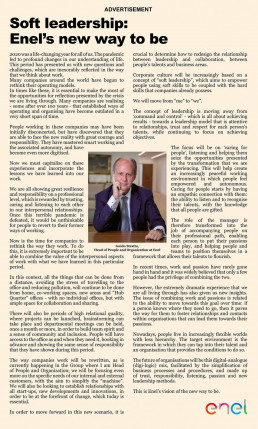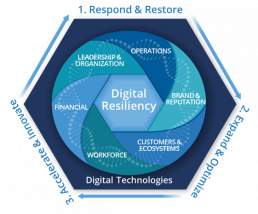COVID-19 has taught us that organisations that have made investments in digital technologies and tools have been more resilient than those that haven’t. Whether it’s a brick-and-mortar shop delivering its products to its customers’ door, a school running lessons remotely or a milk producer distributing its products, in the past year companies have understood the central role of digital technologies not only to keep operations running but also to innovate and pivot to new requirements. This has also accelerated digital transformation (DX) for many organisations.
According to SAP CEO Christian Klein, “The recent pandemic is a crisis that will drastically impact societies and business for months and probably years. Digital transformation is no longer an option, but a must.”
We live in a global, interconnected world and systemic crises like COVID-19 are more likely than ever, so a key question for business leaders is how prepared they are for future shocks. As one of IDC’s CIO Advisory Board members said, “We have experienced a crisis — will we really be more resilient to shocks in the future?” This is the top priority for about 60% of EU organisations in 2021, according to our recent IDC IT Buyer Sentiment Survey.
“Many companies are realising that established ways of operating and organising have become outdated in a very short span of time … Now we must capitalise on these experiences and incorporate the lessons we have learned into our work. We are all showing great resiliency and responsibility,” said Guido Stratta, head of people and organisation at Enel.
But what does it mean to be “digitally resilient”?
To be Future Ready You Need to be Digitally Resilient
One of the key lessons learnt from the pandemic is that traditional approaches to IT risk and business resiliency were not good enough and many companies were not properly prepared to deal with the crisis. Business leaders looked to digital technologies to maintain operations and some looked to digital to help them quickly pivot their business and capitalise on the changing market conditions. This is why, IDC believes, that to be successful in the digital economy, IT and business resiliency approaches need to merge into a new approach — what IDC calls digital resiliency.
Digital resiliency is an organisation’s ability to rapidly adapt to business disruptions by leveraging digital capabilities to not only restore business operations but also to grow and capitalise on the changed conditions.
Digital Resiliency Framework
IDC has created a Digital Resiliency Framework which includes three phases of response to a crisis and six organisational dimensions that are all enabled by a shared digital technology architecture. For each organisational dimension, IDC has identified the key business priorities to improve resiliency within that dimension at each phase of response. In addition, IDC has highlighted the key use cases and enabling technologies that can help business leaders to achieve these business outcomes.
To survive and thrive in the next normal, digital resiliency must be achieved within each of these six organisational dimensions:
- Leadership and organisation: The business leadership and the CIO office need to work in tandem with the rest of the organisation to mitigate weaknesses across all dimensions, understanding the interdependencies and pulling them together.
- Workforce: The focus is on optimising the employee experience in times of extreme uncertainty. Specifically, this covers important issues such as employee engagement and productivity, retention and onboarding, skills and learning, and health and wellness.
- Customers and ecosystems: This includes customer, supplier and partner engagements and how to develop, retain, renew and optimise these relationships in a crisis.
- Brand and reputation: Customers, partners and suppliers all look at how an enterprise responds to a crisis as a measure of the quality and integrity of an organisation and its leadership. Trust in an enterprise’s brand and its reputation is slowly won but quickly lost.
- Financial: An organisation’s outstanding liabilities and available financial resources clearly determine its short-term survival. But financial resiliency is more than this — it also includes an organisation’s ability to learn from the past to predict potential future financial threats.
- Operations: Operational resiliency goes beyond traditional business continuity planning, using agile and adaptive planning techniques to build incremental and opportunistic responses to operational problems due to internal challenges and external/ecosystem dynamics.
3 Steps for Leaders to Become More Digitally Resilient
- Assess where you are and benchmark against your peers
Understanding how to improve digital resiliency will require you to have a clear idea of the starting point. The IDC Digital Resiliency Framework is a useful tool for companies to assess their own digital resiliency against these six dimensions. IDC will soon be launching a scorecard to enable companies to understand their level of resiliency and risk, benchmark against peers and plan the next step to improve their resiliency.
- Set your compass towards digital resiliency
Once you have a clear starting point you will have a clear map of the areas of improvement and the key use cases and technology investments you will need to prioritise to progress along the road map and become more digitally resilient.
- Never stop improving
Digital resiliency is not just about restoring operations and keeping the business running. Companies need to adapt, anticipate future scenarios, accelerate innovation and create new opportunities. That’s why digital resiliency is a central tenet of the platform-enabled, ecosystem-centric, data-driven and fuelled-by-innovation future enterprise.
We expect the next normal to continue to be volatile, uncertain, complex and ambiguous (VUCA). Digital resiliency is key to not only operating in a crisis but also to driving innovation. IDC’s research shows that one in two European organisations believes that having a digitally resilient organisation will help it to introduce new business model innovation (source: IDC COVID-19 Impact Survey, Wave 14, November 10–20, 2020; n = 765).
As Microsoft’s Satya Nadella said: “There’s no going back in the sense that the digital technology is going to be very much part of our economy, part of our lives, part of our society, and increasingly so, and [none of us can predict] the next tail event. But having more digital technology in our fabric will help us navigate whatever that tail event is.”
Check out more information in our Digital Resiliency page.




